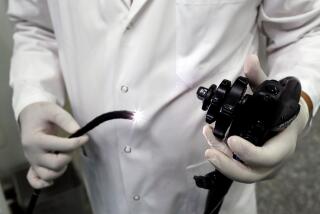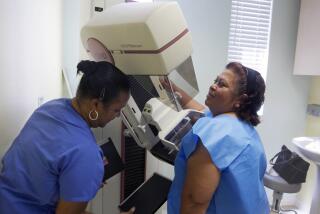Cancer screening: An example of when less can be more, experts say

Doctors should stop screening most women for ovarian cancer, according to new guidelines from the American College of Physicians. That means no more blood tests to check for a biomarker known as CA-125.
Americans get too many tests to screen for common types of cancer, and the American College of Physicians wants them to stop.
New clinical guidelines from the medical group include a litany of statistics that illustrate our obsession with cancer screening. Among them: About 6 in 10 adults submitted to a colonoscopy more often than they needed to. One-third of men who got a PSA test to screen for prostate cancer couldn’t remember being asked by their doctor to do so. And 69% of women who had their cervix removed during a hysterectomy still got tested for cervical cancer.
“Cancer screening is more popular among the U.S. public and is done more frequently than in other countries,” according to the authors of the guidelines, which were released Monday.
This is not to say that there’s no place for cancer screening, the authors wrote. But in many cases, the way to increase the value of screening tests is to do fewer of them, not more. That’s because “less-intensive screening leads to little loss in benefits and larger reductions in harms and costs,” they wrote.
The guidelines cover five common types of cancer – breast, prostate, colorectal, cervical and ovarian. The advice offered by the members of the American College of Physicians’ High Value Care Task Force applies to people who have no signs of illness and no reason to suspect their cancer risk is higher than average.
BREAST CANCER
- Doctors should encourage women to get mammograms once every two years when they are between the ages of 50 and 74.
- They should discuss the pros and cons (including the risk of overtreatment) of mammography with women in their 40s and order the test once every two years for patients who would like it.
- Doctors should not order mammograms for women under the age of 40 or over the age of 75.
- They should not order an MRI or use another radiologic test called tomosynthesis to screen for breast cancer.
PROSTATE CANCER
- If a patient asks about getting a PSA test, doctors should initiate an in-depth conversation about the “limited potential benefits and substantial harms” of the test. This conversation should make clear that the test should be considered only for men between the ages of 50 and 69.
- Doctors should only order a PSA test for a patient if he has thoroughly considered the benefits and harms and expressed a “clear preference for screening.”
- The test should never be ordered for men who are younger than 50 or older than 69. The test should also be off-limits to men if their life expectancy is less than 10 years.
COLORECTAL CANCER
- Doctors should only screen patients for colorectal cancer if they are between the ages of 50 and 75 and have a life expectancy of at least 10 years.
- Doctors should offer patients one of four screening tests. These include a traditional colonoscopy, which should be repeated once every 10 years; a sigmoidoscopy, which should be repeated once every five years; an annual high-sensitivity fecal occult blood test (FOBT) or fecal immunochemical test (FIT); or a FOBT or FIT once every three years plus a sigmoidoscopy once every five years.
- Tests should not be performed more frequently than necessary.
CERVICAL CANCER
- Doctors should perform a Pap test on their female patients when they are 21 (but no sooner). If the results are normal, the test should be repeated once every three years.
After women turn 30, they may combine a Pap test with a human papillomavirus, or HPV, test and reduce the screening frequency to once every five years. HPV testing should not begin before a woman turns 30.
- Regular screening should stop when women turn 65 if they have had all their recommended tests in the previous 10 years (either three rounds of Pap tests or two rounds of Pap-plus-HPV tests) and all of the results were normal.
- Doctors should not perform a manual pelvic exam to check for cervical cancer.
- Doctors should not do any kind of cervical cancer screening for women who have had their cervixes removed.
OVARIAN CANCER
- Doctors should never screen asymptomatic, average-risk women for ovarian cancer. That means no pelvic exams, no transvaginal ultrasounds, and no blood tests to check for a biomarker known as CA-125.
The High Value Care Task Force compiled these recommendations by looking for areas of agreement between the American College of Physicians, the American Academy of Family Physicians, the American Congress of Obstetricians and Gynecologists, the American Urological Assn., and American Gastroenterological Assn., the American Cancer Society and the U.S. Preventive Services Task Force.
Some patients may be happy to get fewer cancer screening tests, but others may resist, the authors of the guidelines acknowledged. If so, doctors may need to help them change the way they think about screening.
“Rather than assuming that all screening is high-value, clinicians might start a conversation with the understanding that it always involves tradeoffs between benefits versus harms and costs,” the authors wrote. They could also reassure them that “some patients may reasonably decide that they would prefer less intensive screening.”
For more medical news, follow me on Twitter @LATkarenkaplan and “like” Los Angeles Times Science & Health on Facebook.







